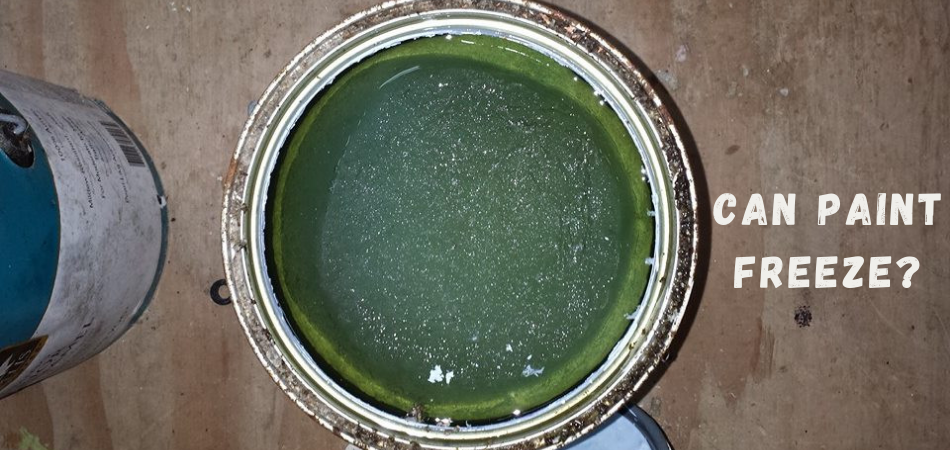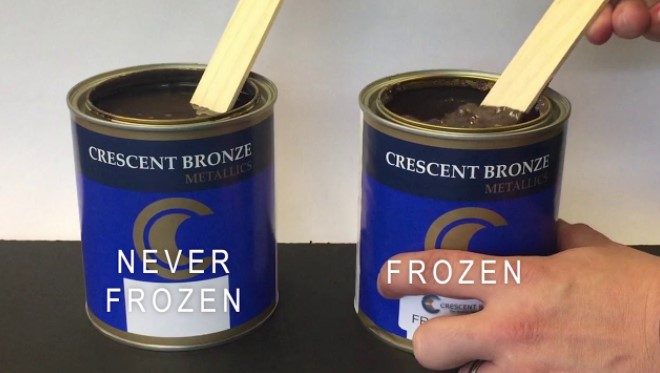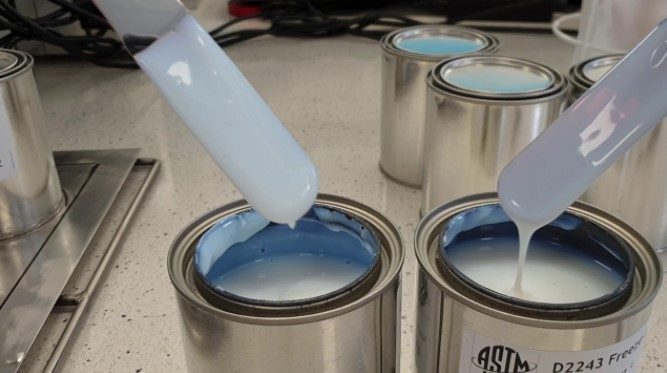Randy Charles is the owner of PaintCentric.com, a website dedicated to providing information, tips, tricks, and news about all things paint. With over 10 years...Read more
Are you a painter or someone who does a lot of work with paint? If yes, you might be worried about the winter seasons and how they can affect your paint. Well, you’re not alone because we often hear a lot of people asking, can paint freeze?
Anything with a solvent can easily freezeand paint has a liquid solvent that evaporates when it is on the wall. Frozen paint can be messy, stringy, grainy, and spoiled. Sometimes, frozen paint can even give out a terrible odour.
You might want to know many things about frozen paint, including why paint freezes? Is frozen paint safe? Is it possible to use paint after it has frozen? If you want to save your paint from disaster, read on.
Is frozen paint safe?
Frozen paint is safe to use if, after mixing it, it doesn’t form lumps. But, if it does, you must throw it away, and it is safe to use if the paint doesn’t have a pungent odour.
You should have in mind when considering if frozen paint is safe is the paint’s consistency. If the paint returns to a smooth texture after stirring it, it is safe for use. But, if it has some lumps that don’t mix with the paint, you should consider disposing of it.

You should also consider how old the paint is and how many times it has frozen, as a paint that has only frozen once and thawed once will still be good to use. But, older paints don’t last long and are likely to get spoiled faster.
Can paint freeze?
Liquid paint has a solvent that makes it freeze when exposed to chilly temperatures. It also depends on the kind of paint you use. For example, suppose you use water-based paint, and it remains in the can until cold temperatures come. In that case, the paint will freeze depending on the water quantity in the paint.

So, if you leave your paint remnant in its can for a while, you can come back to meet it morphed into something else. Frozen paint becomes stringy, grainy, and solidified at the base of the can. Its colour can quickly transform into something repulsive and unwanted.
In addition, frozen paint sometimes gives off a pungent smell that can make you run for cover. So you now have your answer to can paint freeze?
Why Do Paints Freeze?
Paints do freeze because of the amount of water (water content) available. However, it depends on the types of paint, as different types of paint have different freezing points. Also, note that this paint solvent makes paint freeze within a can and not freeze when applied on the wall as wall paint.

Thus, if you store your paint in a can out in the open in your store or garage, you might return to find it spoiled within months. It is best to store your paint cans in secure, dry, and warm locations.
Also, if you have remaining paint to keep, you’d need to find out if it is the kind of paint that is prone to freezing or not.
Related:How To Paint Over Peeling Paint?
How fast does paint freeze?
The time taken for liquid paint to freeze depends on the environment’s temperature. Latex paints freeze at the same rate and temperature as water. However, the oil-based paint freezes much faster and at a lesser temperature than the latex paint.
There are basically 3 determinants to how fast your paint can freeze, and wed look into them shortly. They include:
- The kind of paint.
- Storage location
- Freezing temperature.
Lets demystify these factors.
The kind of paint
Latex paints (or water-solvent paints) have an equal freezing temperature as water which freezes at 0oC (Degree Celsius) or 32oF (Degree Fahrenheit).
On the other hand, oil-solvent paints are less prone to freezing because of the oil. Most oil-solvent paints use linseed oil, and linseed oil has a freezing temperature of -21 o C (Degree Celsius) or -4 o F (Degree Fahrenheit). Freezing!!
In some countries, you don’t have to be concerned about if your oil-solvent paints will freeze. But during winter, you need to be more alert because temperatures can get below zero degrees.
Storage location
You need to learn how to store your paint in a safe location. If you expose the paint to the elements, it will inevitably freeze much faster than usual. Therefore, you should store your paint so it will not be exposed to cold temperatures.
You can store your paint in your garage with no temperature control installed. Just ensure to place it near the garage door where it can receive sufficient radiant heat. This way, it will not freeze easily.
In addition, ensure to check the paint’s freezing point, as different paints also have different freezing points due to their compositions. Finally, you should check properly to store the more prone paints to freeze in warmer locations.
Freezing temperature.
Paints that use water as their solvents, like latex paints, are more prone to freezing faster because they freeze at zero degrees Celsius (0oC or 32oF). Once the paint reaches this temperature, it begins to freeze.
Also, at lower temperatures, like 15oF-20oF, the paint begins to freeze even faster. Thus, paints will freeze much faster at lower temperatures, and at higher temperatures, the paints will freeze much slower.
You need to ensure that the paint is sealed or adequately closed, as this will determine how long the paint can go before freezing.
What temperature does paint freeze?
Typically, water-solvent paint freezes at 0oC (or 32oF), the same as water’s freezing point. However, oil-solvent paint freezes at a colder temperature of -21oC or 4oF. In addition, find out the freezing temperature of your paint at the base or body of the can.
One major thing you need to understand is the temperature that transforms paint from liquid to solid and ruined. However, the solvent used in the paint determines the temperature at which the paint freezes. For example, latex paints (water-based paint) use water as their solvent. This kind of paint freezes at 32oF (equivalent to 0oC), meaning it freezes at an equal temperature to water. On the contrary, the oil-based paint, which uses oil as its solvent, has a lower freezing temperature than the counterparty latex paint.

We know this was because compound oil always freezes much faster than water does at the same temperature.
Although, the freezing point of any paint fundamentally depends on the paint’s consistency.
Will paint freeze over winter?
Paint freezes when exposed to freezing temperatures, and winter is one of them. However, the kind of paint you use determines how fast that paint will freeze. Oil paints generally take more time and require more time to freeze than latex (water-based) paints.
Can Paint Be Used After It Freezes?
You can use frozen paint after it freezes if it doesn’t give you separations or lumps after stirring the thawed paint, and the texture still keeps its consistency. To find out if it’s still possible to use your frozen paint, follow these steps below:
- Thaw the frozen paint completely.
- Evaluate it for any separation or lump.
- Mix the paint aggressively.
- Run the paint on any smooth surface.
Here are the details about the steps:
Thaw the frozen paint completely.
The very first thing you need to do is to thaw the paint entirely. By thawing, we mean allowing the frozen paint to melt slowly. We recommend you allow the room temperature to do the thawing for you. Avoid the urge to use your hairdryer or any direct heater, as that will completely affect the process we’re trying to follow and the paint itself.
Thus, let the paint melt slowly.
Evaluate it for any separation or lump.
After thawing the paint, evaluate the paint. If partly froze, the paint would look nearly natural. So, you need to ensure that you assess it a bit further. Occasionally, in frozen paint, it has some lumps resembling cottage cheese.
To look for lumps, pour the paint into another clean paint bucket. While pouring the paint, you will easily see lumps. If there are no lumps, then your paint is good to go. But, if you discover that there are several lumps, you may not be able to use the paint.
However, you can try this other step if you find lumps in the paint and hope to revive it.
Mix the paint aggressively.
Another step to revive your paint with some lumps is to stir it aggressively. Using a solid object, stir the thawed paint vigorously. If the lumps mix with the paint, then it is good enough. But, if the lumps are still solid and don’t mix, then it is not good.
You must, however, ensure to mix the paint vigorously or use an electric paint mixer if you have one. The time taken to mix the paint completely depends on the number of lumps in the paint.
Test the paint on any smooth surface.
Now, you want to test if the paint is good to go. Apply the thawed paint to an unimportant surface. Ensure not to use the paint that has frozen on any essential project. Test the paint on some surface like scrap metal or wood.
In truth, surface testing is a time-consuming process. However, it’s more important to do it effectively than regret making a fatal mistake with frozen paint.
How do I store paint in cold weather?
If you want to store paint during cold seasons, it’s ideal that you store them at room temperature. Doing this will protect the paint’s lifespan, and you can use it again at later times. Also, if you can, store the paint in a cool, dark, and dry place. A place in mid-temperaturenot extremely hot or cold. If you do this, you will prolong the life of the paint.
You can also store your paint in the basement or even within your house. Within these places, you will quickly get a stable room temperaturealternatively, any location with temperature control, where the cold from outside can’t intrude.
Optimal room temperatures for storing paint during cold seasons range from 60oF to 80oF.
When to dispose of frozen paint
You can dispose of frozen paint after you have thawed and stirred it continuously, but you still discover that it forms lumps.
Not all frozen paints can be restored, and they are not what you want to discover, especially if the paint in question is valuable to you. Some paints get frozen past the restoration point. So, how do you know when it’s time to dispose of the frozen paint?
First of all, to determine if you can salvage it, pour out the entire paint into another container. When you have done that, stir it using something solid and firm. If, while or after stirring, the texture becomes creamy and smooth, then it’s not entirely bad. You can use it.
However, if you discover some lumps appear after stirring and no longer have their formation, you should take them to the trash.
How do I restore frozen paint?
To restore frozen paint, ensure to thaw it out completely, then use a solid long object and stir continuously for a while. If the paint returns to its original state after you’ve done that, then it’s good to go!
However, this only works in latex paint, not oil paints. This is so because mostly, when oil-based paints freeze, they become destroyed.
Final Verdict
If you often use large quantities of paint, you may ask, can paint freeze? It’s natural to wonder, and we are glad to assist you. Paint can freeze because it has a solventvirtually everything that has a solvent can freeze.
Water-based paints freeze at the same temperature as water (0oC), whereas oil-based paints freeze at colder temperatures (-21oC). Thus, you need to know how to correctly take care of your paint.

Randy Charles is the owner of PaintCentric.com, a website dedicated to providing information, tips, tricks, and news about all things paint. With over 10 years of experience in the painting industry, Randy has become an expert in the field and is passionate about helping others learn more about painting. He has written numerous articles on the subject and is committed to providing accurate and up-to-date information to his readers.
- Latest Posts by Randy Charles
-
How Much Do You Tip Painters? The Ultimate Guide
- -
Can You Paint Over Rust Converter?
- -
Can You Paint Inside When It Is Raining?
- All Posts
